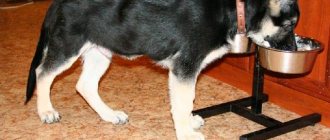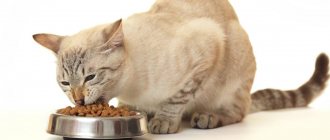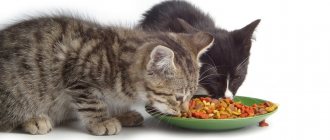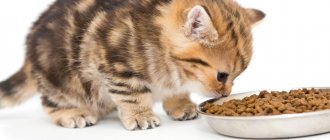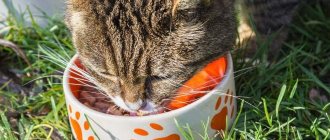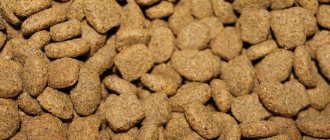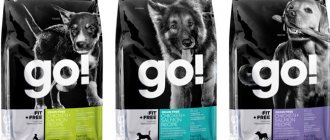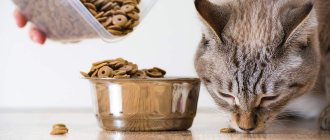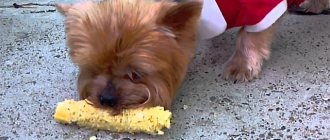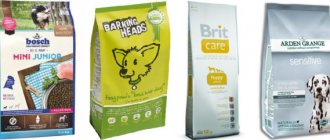Today I want to tell you about how to properly feed a puppy. After all, your fluffy should receive everything he needs for his growing body and grow up strong and healthy.
Of course, you won’t be able to immediately remember all the subtleties of this process. But every day you will gain more and more experience, constantly learn something new and useful. Eventually, you will become well versed in feeding your dog naturally.
And I hope that my advice will help you with this.
Selecting the type of feeding at home
The question of which food is better, healthier – natural or industrial – is incorrect. The right decision would be the type of feeding that suits both the dog and its owner. If you cannot buy quality food for your pet and constantly monitor its freshness, purchase ready-made food. When choosing natural food, do not forget about vitamin supplements in your diet, which are so necessary for a growing body.
Dry food reduces the cooking process to a minimum. This option is ideal for a busy person who does not want to spend time at the stove often. In addition, the balanced composition of high-quality food already contains vitamin and mineral supplements for puppy health. An undoubted advantage will be the long shelf life of goods and a variety of tastes, but the disadvantage of ready-made food is its cost. A high-end product cannot be cheap.
Vitamins and supplements
If the dog eats natural food, then the owner needs to wisely select the diet so that it includes absolutely all useful substances: minerals, trace elements and vitamins. It will not be possible to solve the problem with natural food alone - the animal will need supplements from a veterinary pharmacy.
Before deciding what supplements you can feed your puppy, carefully study the list of vitamins that the animal needs: vitamin A, D, E, group of vitamins B. You can purchase special supplements and give them with food.
There are 2 types of vitamin and mineral supplements:
- Industrial
. The best are considered to be 8 in 1 Excel Multi Vit, Canvit Junior, Beaphar for puppy, Biorhythm, Doctor Zoo.
- Natural
. Brewer's yeast, feed sulfur, bone meal, calcined cottage cheese, fish oil.
Large breed puppies (for example, St. Bernard, Rottweiler, Alabai, Samoyed) are given calcium, phosphorus and magnesium for the proper formation of bones and joints. And in winter, all puppies are recommended to take fish oil, vitamins A and D to prevent rickets and better protect against the cold.
Before you start giving your dog vitamin complexes, you should consult your veterinarian. He will prescribe the right dosage for your pet, based on the breed of the animal, its health condition and blood and urine tests. You cannot give vitamins thoughtlessly, as this can seriously harm the animal. Vitamin support is needed to improve the condition of dogs after illness, during pregnancy, during active growth, but strictly under the supervision of a veterinarian.
In pets who regularly receive dry food, vitamin deficiencies are less common. This is due to the fact that high-quality feed mixtures contain useful additives. If you administer drugs during dry feeding, this will lead to hypervitaminosis.
Before or after a walk
Social skills training begins from the moment a pet arrives in a new family. The sooner the baby understands the rules of behavior in society, the easier it will be for him to adapt to unusual conditions.
Puppies 1 – 2 months old are just getting used to the toilet and will want to relieve themselves after feeding. Select the timing of walks taking into account this need of the growing body and avoid increased activity of your pet on the street. As you get older, walk your dog only before meals. This is an excellent prevention of volvulus and a natural way to increase appetite.
“Patience and more patience!” - this is the motto for the owner of a newborn baby. Until 2 months of age, walk the puppy 6–7 times a day. After feeding, wait 5 - 10 minutes, pick up the baby in your arms and take him to a calm, quiet place where he can do all his business. A grown puppy walks 2 times a day before meals.
After dinner I really want to sleep
Small dogs
Dwarf breeds are small in size. Their diet includes all permitted foods. The main requirement when creating a menu is small portions and small pieces of food.
- Allergenic foods are introduced to puppies with extreme caution. Toy dogs tend to be reactive.
- Therefore, at the first sign of an eating disorder, allergens are removed.
- The average daily amount of food consumed by a small dog after 6 months is about 40 grams per kilogram of weight.
Is it necessary at night
A dog aged 1 - 1.5 months does not need night feedings. Surely it will not do without “whims” on the part of the pet. This period must be endured, creating comfortable conditions for a restful night's sleep.
Provide your puppy with a nutritious dinner no later than three hours before bedtime and limit access to liquids immediately before bed. Why is this necessary? It's simple: a puppy's body needs time to digest food.
If you feed him before bed, you will end up with endless trips to the toilet instead of a comfortable sleep. And by walking the dog before going on vacation, you can probably relax yourself.
And a little hint: a tired pet is a sleepy pet. Play with your puppy in the evening, let him get rid of pent-up energy, and by the time he goes to bed at night, he will want to get some sleep.
Dependence of diet on breed
The nutrition of puppies depends not only on their age, but also on the breed. The size of the pet and its activity determine the serving size.
Large and active dogs expend more energy, so they require more food. Dwarf breeds can survive on less food.
Food fusion for kids
When choosing a diet for a newborn puppy, some owners try to replace dog food with baby formula, believing that there is no fundamental difference between these products, and the cost is significantly different. Is it so? Let's figure it out.
Newborns and puppies have completely different metabolisms and replacing ready-made puppy food with baby formula is unacceptable. Baby products cannot be a substitute for dog food, because they have a different composition of nutrients and a different consistency. As for canned meat for children, they are sold in the form of overcooked puree, which is not healthy for the dog. The exception is fermented milk products for children. You can periodically pamper your pet with low-fat baby cottage cheese, kefir and sour cream.
If you want to offer your puppy formula, do it infrequently, no more than 2 times every 10 days as an addition to the main diet.
Is it possible to soak food?
Up to 3 weeks, the puppy eats only mother's milk, which has a liquid consistency, so there is often a need for an intermediate stage between it and solid food. Some owners prefer to start feeding their pet more mature food, soft purees and pates.
If the choice is immediately made in favor of feeding the puppy dry food, but it is difficult for the baby to chew it, it is allowed to soften the granules with plain water or boiled cow’s milk at first. The easiest way is to add a small amount of warm liquid (40-50°C) to the measured portion 20-30 minutes before meals. You should make sure that the hard pieces have time to get wet, and the consistency begins to resemble puree. Sometimes dry food is ground up before liquid is added to it.
Expert opinion
Anna Abramenko
An avid dog lover. Experience in veterinary medicine since 2009.
Ask a Question
The older the baby gets, the less water and milk needs to be added. Usually for a 2-3 month old puppy this is not necessary - he chews dry food confidently.
The portion of soaked food looks larger than dry food, but there is no need to reduce it. It is unacceptable to fill granules with liquid for future use: they quickly begin to deteriorate and are stored for up to 3 hours in a warm place, 12 in the refrigerator.
Is it possible to have raw meat?
No matter what “knowledgeable” dog owners say, dogs can eat raw meat. Moreover, from any age, with the exception of the neonatal period, when the puppy is still inseparable from maternal feeding. Feel free to offer your pet pieces of lamb, chicken, and beef. Pork - no.
You can protect your puppy from infections and helminths present in the raw product by following simple rules:
- purchase meat products from trusted suppliers;
- deep freeze the meat in the freezer (at least 3 days after purchase);
- Before feeding, pour boiling water over the meat to disinfect the incision area.
In this way, you minimize the risk of infection, and timely deworming of the puppy will reduce the threat of infection to “no”.
Puppies love milk
Medium dogs
Medium breed dogs are more often classified as hunting dogs. They are active, mobile and expend more energy during the day. Such animals require more food.
The main emphasis in nutrition is on protein foods. Dogs also require calcium for bone development.
It is important to remember that dogs gain weight easily, so fatty foods, sweets, and an abundance of bread are not allowed in their diet.
Whole milk
The composition of dog milk is unique. If there is a need to replace maternal nutrition, then the dog owner’s task is to choose an alternative feeding option that is suitable for the pet.
The right solution is a special mixture for feeding newborn puppies.
Whole milk is an acceptable food for a puppy, but not ideal. You can use this food if you don’t have a store-bought ready-made formula. Which milk can be considered as a replacement for mother's milk, and which is contraindicated? Let's study in more detail:
- cow's milk is less fatty than dog milk, but may not be absorbed by the puppy's body;
- mare - high lactose content, not recommended for puppies;
- almond – safe when introduced into a dog’s diet in small quantities;
- coconut – safe in small doses, but too sweet for dogs;
- goat - allowed to be used from the age of two weeks. Increase the nutritional value of the product by adding a quail egg.
Small breed dogs consume milk up to one and a half months of age, while large dogs consume milk up to 3 months. After this period, milk can be completely eliminated from the diet. This is due to the peculiarities of the functioning of the puppy’s body. As a dog gets older, its production of enzymes that break down lactose decreases, which can lead to problems with the gastrointestinal tract.
Dangerous! Avoid milk if your pet develops vomiting, allergies, or diarrhea.
How to determine the correct serving size?
New owners of two-month-old puppies often go from one extreme to another: either it seems to them that they are overfeeding the baby, or they think that they are underfeeding.
Both overeating and undereating are bad. But for the health of the heart and joints, it is better to slightly (just slightly!) underfeed your dog. This advice is especially useful for large breeds (such as German and Caucasian Shepherds, Alabai, VEO), whose bones and ligaments are already under heavy stress.
The amount of daily food should be approximately 5-7% of the dog’s weight or 260-270 kcal per 1 kg. But this is an average rule.
You can more accurately determine what portions to give your puppy at 2 months.
Place a bowl of food. Normally, the baby eats food in 10-15 minutes and licks the bowl a couple of times. If after 15-20 minutes there are food left, you are overfeeding the dog. If your pet swallows a portion in 2-5 minutes and licks the dishes for a long time, you are underfeeding.
There is another option. Give the puppy a known large portion. Keep an eye on the dog: as soon as the last (false) ribs are visible, take the bowl away. This way you will slightly underfeed the dog. This method is used for hunting breeds of lean build - shorthaired pointer, drathaar, Russian hunting spaniel.
There is no such problem with ready-made food. The package indicates the exact daily drying volume based on the weight of a two-month puppy. The only thing is that the amount sometimes has to be adjusted if the baby has an accelerated or slow metabolism.
Pasta
Dogs, unlike people, do not need a variety of food. The desire to treat a puppy to pasta most likely arises from his owner either out of curiosity, or in order to save time and quickly “fill his stomach” before the next feeding.
Good quality pasta consists of just flour and water, sometimes with the addition of eggs. There will be no harm from such food, however, there will be no benefit. If your dog does not have allergic reactions to wheat, you can treat him occasionally with pasta as a treat, preferably mixing it with his main food. But don't do it too often. High carbohydrate foods cause flatulence and diarrhea in dogs and disrupt the functioning of the pancreas.
As for instant noodles, you need to forget about them. When dry, it sticks to the gums and can get stuck in the throat, but when cooked, it has no nutritional benefit.
Basic prohibitions
There are foods that are undesirable or strictly prohibited to be given to two-month-old puppies. Of course, the first thing that is dangerous is constant feeding of junk food. But even an accidentally eaten piece can cause serious consequences.
It would seem that a tiny piece of chocolate or sausage once a month will not affect the puppy’s health. But it's not that simple. The product may not harm, for example, a large husky. But for small Shih Tzus or Chihuahuas, a dose of dangerous ingredients in a piece will be fatal.
Strictly prohibited and “controversial” products
Absolutely harmful to all puppies:
- salty, spicy, smoked, fried, fatty foods;
- semi-finished products and fast foods;
- sausages, canned food, marinades;
- garlic, onion;
- citrus fruit;
- sweets (especially chocolate), confectionery and bakery products;
- grapes, raisins;
- tubular bones of poultry, fish, leather;
- mushrooms, nuts;
- alcoholic, carbonated, sweet drinks.
Some of these products lead to health problems if consumed regularly. Others immediately cause intoxication, allergies, and gastrointestinal disorders.
There are products that some owners consider undesirable, while others consider them harmless if consumed rarely. This:
- pork - raw meat is fatty, may contain helminths, but boiled meat can be fed occasionally;
- potatoes are pure starch when boiled, but you can treat them with 1-2 slices of raw root vegetables;
- tomatoes - a large amount can lead to poisoning, but in small doses they remove plaque from teeth;
- honey is an allergen, but at the same time a storehouse of useful substances;
- semolina and pearl barley are pure carbohydrates and cause bloating, but porridge with milk helps exhausted babies at 2 months to gain weight;
- peas, soybeans, beans, beans, corn: they cause gas formation and are difficult to digest, but if the dog loves them, a few grains will not harm.
Veterinarian advice
How do you know if you are feeding your four-legged friend correctly? The puppy should look lean, that is, you can feel the costal arches through a small subcutaneous layer of fat, its muscles are developed, and its chest is slightly wider than its waist. Without going into details, a healthy puppy looks plump, slightly plump, but not at all fat.
The baby's development may slow down during illness, but will quickly recover after recovery. There is no need to overfeed the puppy at this time. Excessive load on the dog's skeleton can cause osteochondrosis or joint dysplasia. Pay attention to the amount of calcium your pet receives. A deficiency is just as harmful as an excess.
It is very important to adhere to the initially chosen feeding strategy. If you feed your dog natural products, do not introduce ready-made food into the diet, even as an exception. And vice versa: a dog that eats exclusively industrial food will have difficulty digesting human food.
How often do you need to care for your dog’s ears, and what lotions, drops and other products are used at home?
And a little about food culture. The dog’s bowl should be located on a hill so that the dog’s musculoskeletal system can develop correctly. If within 15 minutes from the start of feeding the puppy has not eaten the entire portion, feel free to remove the bowl until the next meal. Are you sure that your pet is getting enough to eat, but despite this, he is constantly begging for food from the owner’s table? Stop such attempts immediately! It’s one thing for a funny puppy whining near its owners, and quite another thing for an adult dog to climb its paws onto the table and leave greasy marks on the tablecloth.
How much food should you give your puppy?
With a natural diet, the daily amount of food consumed by the dog should be approximately 6-8% of the dog's weight. For example, if your pet weighs 10 kilograms, then 7% would be 700 grams.
Feeding a puppy correctly does not mean feeding it to its fullest. Overfeeding is much worse than underfeeding.
You must determine the serving quantity yourself, based on your age and level of physical activity. Appetite can be influenced by many factors. For example, in the summer, when it’s hot, dogs eat much less than in the cold season. Read about what to do if your pet is not eating well.
Knowing whether your puppy is hungry or not is very simple. If the baby licks the bowl after feeding without leaving anything there, this means that the fluffy is not full. In this case, you should increase the portion. Well, if the baby leaves excess porridge in the bowl, then he is completely full.
List of recommended products
Natural nutrition for a puppy allows you to reduce the cost of dry food and significantly diversify the animal’s diet. It is important to choose products that are allowed for your pet.
The list of permitted products includes:
- Diluted milk;
- Fermented milk products (kefir, cottage cheese, whey);
- Lean meat;
- Lean fish;
- Vegetables (onions, carrots, pumpkin, zucchini, beets, spinach);
- Berries and fruits (apple, apricot);
- Cereals (rice, buckwheat, oatmeal);
- Eggs.
Week 8 Landmark
For the first four weeks of a dog's life, only its mother should feed it. If this is not possible, we use special drugs. It is important not to add cow's milk to the diet as it will not provide the necessary ingredients for your puppy.
After these four weeks, solid foods are gradually introduced into the diet. Around the eighth week, dogs can eat cooked food or feed themselves - and this is when they often find their way to their new homes. What is the puppy's diet or what to feed them?
Large dogs
Large dogs require more food. This is due to their size, physical activity, and heating costs. Large pets often live in outdoor enclosures.
- At the age of 6 months they are transferred to 2 meals a day, after a year to 1 meal a day.
- It becomes easier to track the diet of a large dog if you look at how to feed a shepherd puppy.
- At the age of 2 months, he consumes no more than 200 grams of food per day.
- By 3 months the volume increases to 200 grams.
- By 6 – up to 1 liter, and already in a year the dog eats up to 1.5 liters of food.
The natural diet contains vegetables, fruits, cereals, meat and fish products. At the same time, the share of meat occupies at least 50% of the total diet. Nutritional supplements such as vitamins and calcium are mandatory for large breeds.
List of prohibited products
Despite the variety of permitted foods, there is a list of foods that are not recommended for dogs.
The list of prohibited products includes:
- Tomatoes;
- Potato;
- Citrus;
- Raisins, currants, grapes;
- Melon;
- Legumes;
- Cabbage;
- Avocado;
- Rhubarb;
- Mushrooms;
- Nuts;
- Chocolate.
It is unacceptable to include fatty, fried, smoked, salty, and spicy foods in your diet. Alcohol is strictly prohibited.
